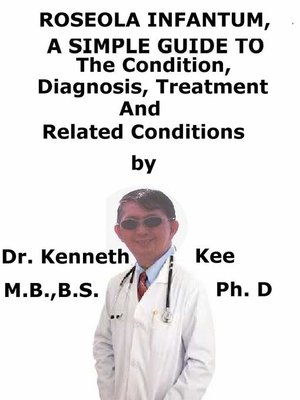Roseola Infantum, a Simple Guide to the Condition, Diagnosis, Treatment and Related Conditions
ebook
By Kenneth Kee

Sign up to save your library
With an OverDrive account, you can save your favorite libraries for at-a-glance information about availability. Find out more about OverDrive accounts.
Find this title in Libby, the library reading app by OverDrive.



Search for a digital library with this title
Title found at these libraries:
| Library Name | Distance |
|---|---|
| Loading... |
This book describes Roseola Infantum, Diagnosis and Treatment and Related Diseases
Roseola is a disease produced by the human herpes virus type 6B (HHV-6B) and possibly type 7 (HHV-7).
These herpes viruses have only been recently recognized.
Roseola, rarely known as "sixth disease," is a contagious illness that is caused by a virus.
It shows up as a fever accompanied by a signature skin rash.
Roseola is also called the names roseola infantum and exanthem subitum.
The infection is normally not serious and normally affects children between the ages of 6 months and 2 years.
The illness can also be produced by another herpes virus, called human herpes 7.
Like other viruses, roseola is spread through small airborne droplets of fluid, normally when someone coughs, talks, or sneezes.
The most frequent cause of roseola infection is the human herpes virus 6 but the cause can also be another herpes virus known as human herpes virus 7.
Like other viral airborne illnesses, such as a frequent cold, roseola spreads from person to person through contact with an infected person's respiratory secretions or saliva.
A healthy child who shares a cup with a child who has roseola could be infected by the virus.
Roseola is contagious even if no rash is evident.
That indicates the disorder can spread while an infected child has only a fever, even before it is clear that the child has roseola.
The doctor should look for signs of roseola if the child has interacted with another child who has the illness.
Unlike chickenpox and other childhood viral illnesses that spread rapidly, roseola infrequently cause a communitywide outbreak.
The infection can happen at any moment of the year.
Risk factors
Most children (86%) will have infection of roseola by the age of 1 year.
Roseola is seldom seen in adults, as infection during childhood probably provides lifelong immunity to the disease.
Repeat attacks have been acknowledged to happen but are not frequent.
Older infants are at the highest risk of acquiring roseola since they have not had time to develop their own antibodies against many viruses.
While in the womb, the babies acquire the antibodies from their mothers that protect them as newborns from contracting infections, such as roseola.
But this immunity diminishes with time.
The incubation period for roseola is about 9–10 days after exposure.
The most frequent symptoms of roseola are a sudden, high fever accompanied by a skin rash.
A fever is indicated high if the child's temperature is between 102 and 105°F (38.8-40.5°C).
The fever normally lasts 3-7 days.
The rash develops after the fever subsides, normally within 12 to 24 hours.
The skin rash is pink in color and can be flat or raised.
It normally begins on the abdomen and then spreads to the face, arms, and legs.
This hallmark rash is an indication that the virus is at the end of its course.
In many cases of roseola, the child looks well with few or no signs or symptoms.
Typical cases are featured by these:
1. High fever (often up to 40 C) for 3–5 days
2. Upper respiratory symptoms such as a sore throat, cough, runny nose or congestion
3. Irritability and tiredness
4. The rash appears around days 3 to 5, as fever subsides:
a. Typically small rose-pink or red raised spots (2–5 mm in diameter) that blanch (turn white) when touched
b. Some spots may be enclosed by a lighter halo of pale skin
c. Mainly affects trunk and seldom spreads to involve the neck, face, arms and legs
d. Similar spots...







